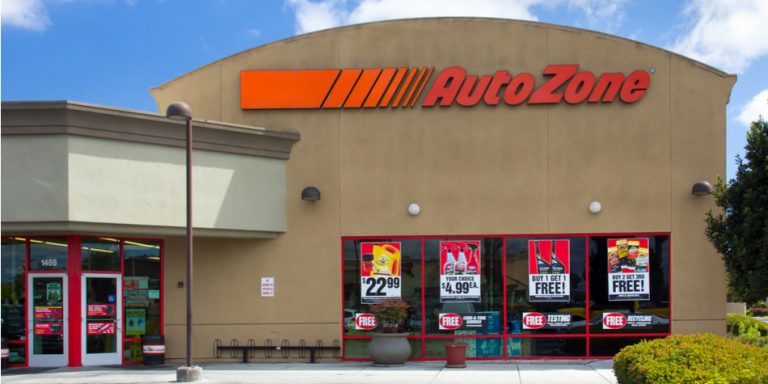The multi-year problem for AutoZone, Inc. (NYSE:AZO) has been an inability to clear the $800 per share mark. The level served as solid resistance for AutoZone stock from late 2015 through early 2017.
Then, a little over a year ago, fears of Amazon.com, Inc. (NASDAQ:AMZN) sent auto parts retailers plunging. AutoZone stock briefly dipped below $500, rallied again to that $800 level, and as of this writing, has pulled back ~23% to the $610+ range.
It’s been a dizzying move, even by the standards of a retail space that has seen huge swings in sentiment over that time. And it leaves AutoZone stock in an interesting spot. AZO trades at less than 11x FY19 consensus estimates. It’s notably cheaper than rivals O’Reilly Automotive Inc (NASDAQ:ORLY) and Advance Auto Parts, Inc. (NYSE:AAP) on an earnings basis. And while some AZO bears have pointed to a potentially weak balance sheet, AutoZone’s leverage isn’t notably different from those two peers.
If an investor believes the Amazon fears are overblown, AZO looks like the right play. But that’s a big ‘if’.
The Auto Parts Space and AutoZone Stock
The auto parts industry has slowed a bit of late in terms of same-store sales. That said, the news here still is much better than in many pockets of retail. AutoZone posted same-store sales growth of 2.2% in its fiscal second quarter, after
a 2.3% print in Q1. Both figures represent a solid acceleration from the 0.5% figure seen in full-year fiscal 2017 — and both at least are solidly positive, unlike those of many retailers in apparel and other areas.
Still, the performance of late isn’t as good as it was. And the question is why that is. Are AutoZone and its rivals losing sales to Amazon, or direct offerings from companies like Genuine Parts Company (NYSE:GPC)? Or are other factors at play?
There’s a strong case that the problem of late is cyclical — not permanent. New car sales peaked in 2016. That’s a headwind for auto parts retailers, as new cars generally require less service — and fewer parts — than older models. Weather has been relatively good, particularly the last couple of winters, limiting maintenance needs. The bull case for the auto parts sector simply is that the industry is having a couple of bad years, driven largely by one-time factors.
And those factors should reverse. The U.S. just experienced a much more difficult winter. New car sales are declining, if modestly, which raises the average age of cars on the road and suggests more demand going forward. The weakness in the industry, whether it’s AZO’s declining comps or the back-to-back negative prints posted by Advance Auto Parts, should turn into strength at some point. And that in turn suggests a potential rebound for the industry.
AZO Stock Is the Play — If the Bulls Are Right
Again, there’s a strong argument for the bull case. But, personally, I’m not quite convinced enough to take a flyer on AZO stock just yet. Amazon may not be a threat right now — but it very well could become one. The retailers argue that it will take the online giant years to manage the same relationships auto parts retailers currently have with suppliers — which might be true. But Amazon has been able to manage similar negotiations across a range of industries.
More broadly, the pressure on retail of late isn’t just about Amazon. It’s about the fact that e-commerce generally dampens margins and hits pricing. The ability to know everyone’s price at every time leads to higher promotions and lower pricing. The auto parts space may be more protected than most — but there’s likely to be some pressure in the mid-term from the changing state of retail. Longer-term, self-driving and electric cars could add further demand pressure as their adoption increases.
That said, it’s possible that I’m too pessimistic. And if that’s the case, AutoZone stock does look like the right pick. Again, it’s cheaper than rivals, with a forward P/E of 11x against 15x for struggling AAP and 17x for ORLY. As for debt, AZO stock doesn’t really stand out.
Adjusted debt (which adds capital leases and rent) to EBITDAR (earnings before interest, taxes, depreciation, amortization, and rent) figures aren’t much different. As of February 10, AZO’s multiple stands at 2.5x. As of year-end 2017, ORLY was at 2.1x, and AAP 2.9x.
Bottom Line for AutoZone Stock
AZO stock also has had the worst performance so far this year, dropping 9% while its rivals have gained. (AAP actually has jumped 19%, thanks to optimism toward its turnaround.)
So if investors see the auto parts sector as worth investing in, AutoZone stock undoubtedly is the play. I’m not quite convinced myself. But a cheaper AZO stock price and/or better news could change that in a hurry. And I wouldn’t be at all surprised if AZO challenges that $800 mark once again in the not-too-distant future.
As of this writing, Vince Martin has no positions in any securities mentioned.

